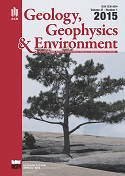Second occurrence of the new mineral harmunite CaFe2O4, Negev Desert, Israel.
DOI:
https://doi.org/10.7494/geol.2015.41.1.142Keywords:
Harmunite, Pyrometamorfic, Hatrurim ComplexAbstract
Harmunite (ideally CaFe2O4) was found in the natural environment for the first time in 2014 in pyrometamorpic larnite rocks of the Hatrurim Complex that lies near Jabel Harmun – moutain located in Judean Desert, Israel - from which it derives its name (Galuskina et al. 2014). Macroscopically, together with srebrodolskite and magnesioferrite, harmunite creates black porous aggregates (Galuskina et al. 2014). In reflected light with crossed polars it has light gray colour with characteristic red internal reflections (Galuskina et al. 2014). Harmunite occurs as crystal faceted by the simple forms {100}, {110}, {210}, {011}, {001}, and {010} or as rounded fragments (Galuskina et al. 2014). The structure of CaFe2O4 consist of double rutile-type ∞1[Fe2O6] chains, which are further linked by common oxygen corners creating a tunnel-structure with large trigonal prismatic cavities occupied by Ca along [001] (Galuskina et al. 2014). Synthetic compound CaFe2O4 is known and used as ceramic material and pigment, semiconductors, refractories, thermally stable material and others (Candeia et al. 2004, Kharton et al. 2008). This phase was also previously found in the Salair pyrometamorphic complex of Kuznetsky coal basin in south – west Siberia, Russia (Nigmatulina & Nigmatulina 2009) and Chelabynsk coal basin, Southern Urals, Russia (Chesnokov et al, 1998) and described as “aciculite”, but it was not approved as a mineral due to its anthropogenic origin (Galuskina et al. 2014). We found harmunite in pyrometamorphic gehlenite rocks of the Hatrurim Complex located in north – east part of Negev Desert, Israel. As for the holotype specimen, it forms aggregates with srebrodolskite and Mg – ferrite. Single grains of harmunite from Negev reach about 25 μm in size. In comparison with holotype specimen, this harmunite contains more varied substitution at octahedral site , where Fe3+ is substituted by Cu, Ni or Zn. Futhermore, there is no Al, which was noted in holotype harmunite. The Raman spectrum of harmunite from Negev is similar to spectrum of holotype specimen and of the synthetic analog. The main Raman bands of harmunite from Negev are as follows (cm–1): 1241, 648, 601, 526, 439, 376, 301, 277, 214, 166, 131, 91.
Downloads
References
Candeia, R.A., Bernardi, M.I.B., Longo, E., Santos, I.M.G., and Souza, A.G. (2004) Synthesis and characterization of spinel pigment CaFe2O4 obtained by the polymeric precursor method. Materials Letters, 58, 569–572.
Chesnokov, B., Kotrly, M., and Nisanbajev, T. (1998) Brennende Abraumhalden und Aufschlüsse im Tscheljabinsker Kohlenbecken—eine reiche Mineralienküche. Mineralien-Welt, 9, 54–63.
Galuskina, I.O., Vapnik, Y., Lazic, B., Armbruster, T., Murashko, M., Galuskin, E.V. (2014)
Harmunite CaFe2O4: A new mineral from the Jabel Harmun, West Bank, Palestinian Autonomy,Israel American Mineralogist, 99 (5-6), pp. 965-975.
Kharton, V.V., Tsipis, E.V., Kolotygin, V.A., Avdeev, M., Viskup, A.P., Waerenborgh, J.C., and Frade, J.R. (2008) Mixed conductivity and stability of CaFe2O4-d. Journal of the Electrochemical Society, 155, 3, 13–20.
Nigmatulina, E.N., and Nigmatulina, E.A. (2009) The pyrogenetic iron ores of the ancient coal fires of Kuzbass. Zapiski Vsesoyuznogo Mineralogicheskogo Obshchestva, 1, 52–67.
Downloads
Published
Issue
Section
License
Authors have full copyright and property rights to their work. Their copyrights to store the work, duplicate it in printing (as well as in the form of a digital CD recording), to make it available in the digital form, on the Internet and putting into circulation multiplied copies of the work worldwide are unlimited.
The content of the journal is freely available according to the Creative Commons License Attribution 4.0 International (CC BY 4.0)










